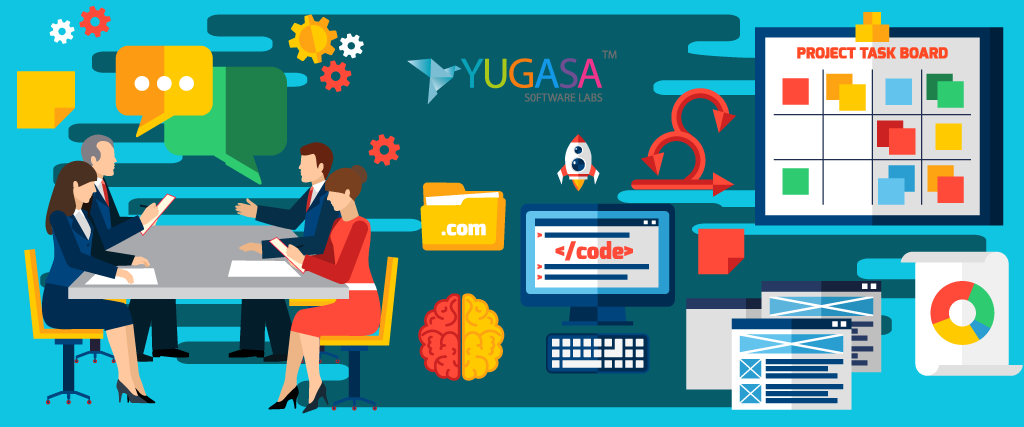Product Development Process: In every sales transaction, the customer has to play some important roles to avoid creating unpleasant situations once the purchase is done. Whether it is a complicated construction contract or the selling of a basic commodity such as bread the customer is always given the right to choose and hence this right to choose must be exercised clearly and accurately.
In either case, the supplier has a considerable responsibility to ensure that the product is intriguing enough and also must have good manpower that can produce this product at a price competitive enough to sell. Neither of these jobs is straightforward. Large amounts of monies are allocated for managerial training and research which will help the producer meet these challenges.
Product Development Process –

However, delivering a service such as the above-mentioned construction service or developing a mobile app requires a step further – how to deal with the customer. Let us imagine a client searches for a service provider, gets different quotes and finally chooses the service provider that suits them best.
The client places great trust in the service provider, trust that the service is well given. With the client’s great trust comes an even greater responsibility for the provider; that to live up to the client’s expectations.
The supplier, or service provider, should have different types of managers in the team. Managers who are useful in this type of project are the Project Manager, the Finance Manager, and the Client Support Manager. The Client might not choose to have these Managers included in the team. It is the supplier’s responsibility to underline the importance of having these Managers oversee the manufacturing of the product.
The Project Manager is the person who handles everything about the product. This means knowing all shareholders and/or sponsors and how to communicate with them. The Project Manager is also responsible for issuing reports about the ongoing procedures, risk assessments and also financial reports which are then passed over to the Financial Manager for vetting.
The Financial Manager handles the regulation of all the monies involved in the production of the project. If a Sponsor is involved, the Financial Manager will work in close contact with the Sponsor. The Financial Manager will develop strategies on how the product will be used to maximize revenues.
The Client Support Manager is the person who is responsible for the client at all times. Dealing with a client requires skill together with a higher dose of diplomacy. This Manager will put the client’s mind at ease. The Client Support Manager will deal with any issues the client has and will organize meetings with the Project Manager so that the client will be informed of all the progress being made.
Many questions arise in a client’s mind after confirming a service provider. If these questions are discussed and answered in agreement with the provider, then many arguments that happen at a later stage can be avoided. Ambiguity must be avoided; it is always better to confirm decisions in writing than verbally since everyone gets busy and maybe a person tends to forget. Both the client and the service provider can have their attorneys meet. These can then draft a legal contract that covers both parties. This contract will include all terms as agreed by both parties. The legal office will also carry out legal research regarding the product such as the registering of trademarks.
Time seems to be quite a Pandora’s box when a client confirms a service provider. One of the main questions that arise is “will I get what I am paying for?” Time is the basis on which certain service providers, such as app developers, are paid. So the customer must first discuss with the service provider how the working hours are going to be monitored.
There are different ways of registering working hours. One way is to use the Global Positioning Satellite, otherwise known as GPS which is built-in on every mobile phone. The service provider can confirm the working hours through a GPS enabled phone given by the client so that movements can be lawfully tracked.
Another way could be by using user-friendly attendance software. The client will have the IT Office that will create an online system that the service provider can use. Keeping a correct record of the working hours ensures the client that the money is being spent in the right way. Keeping a correct record of the working hours ensures the client that the money is being spent in the right way.
Consequently, another point arises – does this service require a managerial post? Someone to keep track of time; someone with whom the client can relate; a manager that can handle concerns professionally; a person who can solve the client’s perturbations. At this point, the service provider will introduce the Managers as previously discussed. The service provider must speak about the functions of every Manager and how they will benefit towards a smooth running of product and client management. The client must also keep an open mind. This will ensure that once Managers are in place the client will have who to contact without actually distracting the service provider from his/her work.
In the case where the client is a large institution, there is already an in-house team that would be appointed to handle such time issues. This in-house team will include lawyers, finance managers, project managers, advisors. Each person will have his/her role in the smooth running of the production.
Read More: DRDO DEVELOPS DEVICES TO SANITIZE PHONE, CURRENCY NOTES
Nevertheless, the client and provider should discuss the time to be spent on such a project. The client must also keep in mind that certain tasks need time and so they cannot have time constraints since these can create flaws in the final product. The customer should think about these matters such as design discussion and implementation, contingency plans, if the need arises, and allocate time for them. The Project Manager must also think closely about every stage of the production. The Project Manager must allocate the necessary time that s/he deems is required for production. S/he must also include extra time for contingency so that deadlines will be met comfortably. This extra time must include time for unexpected delays that fall beyond the control of the service provider.
Another frequent concern in the client’s list is “what is the level of expertise of the provider? How much does this provider know about the project?” A client asks this type of question because ultimately it is the client who is paying for a high-level product. On the other hand, however, for the service provider to answer this question accurately, the client must provide certain details as to what is required, how and when it is needed, and other details relevant to the fine-tuning of the planning. This information will be recorded in the agreement previously mentioned so that both client and service provider will keep track of what needs to be done.
This information is also useful for the creation of the product, the creation of the design. This is one way where the provider can strive to meet the expectations of the client. On the client’s side, this is how the client can, through the advice from his/her specialists, double-check what the provider is creating and hence have a mind at ease. The client must give this information early enough for the providers to make precise planning decisions and to assess and formulate a risk-free design.
This information is considered as discrete and will be presented as drawings, reports, etc. It will be shared in hard copy or digital format and must be shared with all parties concerned. It will also be included in the draft contract which is meanwhile being prepared by the attorneys of both parties.
By knowing this information the provider can then present a draft response that will include preliminary designs and also suggestions of how this design can be implemented. Therefore the provider will demonstrate the level of expertise originally asked by the client. This will strengthen the rapport between the two parties, a clause which is never mentioned in any written agreement but is one of the fundamental clauses without which an agreement cannot be reached.
Brainstorming and sharing ideas is an excellent way of getting to know what the client needs. It is also a great way for the client to know what the provider is presenting. Brainstorming will sieve through several ideas until the perfect one that suits both parties is found. A facilitator is needed for this session. The facilitator can be appointed either by the client or by the provider. A brainstorming session is quite lengthy. It has to be planned. This plan will then be given to the facilitator who will make sure that everyone gets a turn to speak and share his or her ideas. The minutes of this session are then compiled and handed over to the Project Manager and Legal Officer.
Depending on the industry, the provider can create a specimen of the product that s/he will be making. This will be another step that is useful to the client as it will help the client visualize what the final product will be like. This specimen will be designed to test functionality and to remove any flaws and create safety measures.
Going from an idea to a specimen has never been easier or cheaper thanks to modern technologies such as 3D printing, industrial design software tools, and rapid prototyping and tooling. The provider can also rent prototype making equipment such as 3D printers, cutters, sewing machines, laser cutters, etc. The provider could come to an agreement with the client about this and costs can be split.
Another option is for the provider to rent a digital fabrication laboratory, otherwise known as a fab lab. The first of these fab labs was created by a group of MIT students in 2007. Today, we can find them almost everywhere. These labs can be set up to the provider’s needs. The provider can agree with the fab lab suppliers regarding the rental time. Fab labs can be set up with different types of machines that can create a prototype. The provider must discuss the rental costs with the Project Manager who will then seek approval of funds from the Financial Manager.
When the prototype is completed, the client and the provider can agree on having a market test. The market test is done after research about the feasibility of the product or service in the desired market. Once the results are carefully examined the market test can be organized. A market test is done by either using a focus group or by introducing the prototype to a selected group of people. This group of people should know which clients are being targeted and to whom this product will be sold. This group must then produce a report which will speak of the pros and cons of the prototype, how they think it fits in the market. A time frame is previously established. All parties must agree to this – the client, the Project Manager, and the focus group. The service provider must keep in contact with the Project Manager and the client at all times.
Once the market test is over, the provider will compile a report and discuss it with the client. Some points as to what should be discussed – the time needed to do the actual project; the money needed to have it done; what resources are required; how the product can be maintained; what kind of maintenance is most suitable for this product.
At this point, the client will evaluate the best chances for success. A Sponsor is a person or a company that will take over all or part of the expenses incurred to have the ball rolling. The sponsor will work with the provider, the project manager mainly assisting with monitoring the progress of works, meeting deadlines and other ancillary issues related to financial implications for the creation of the project. S/he will work with the client and share the authority to make decisions. The Sponsor must ensure that the project will remain in line with the company or client’s policy. S/he will also work closely with the Financial Manager to ensure the correct outflow of his/her funds. Therefore s/he will remain involved in the project until it is formally authorized.
As has been discussed above, the position of the client is as important as that of any other member of the team. The client must be patient and understanding open to any events that are beyond the supplier’s control. On the other hand the service provider, through the Client Support Manager must provide consultation services, at least daily. During these consultation services, the client will need to know how to make the product better even after the product has been launched.
An after-sales service team could be appointed. This team will be responsible for all queries that the client might have after the closing sale of the product or service. This team will also advise the client on what type of maintenance is best for the product, what updates are needed and when they should be done. This team is there to continue increasing the trust that has been established between the client and the supplier.
Clear communication between parties is one of the key elements for a successful project. If something is unclear to one party the communication link will break. This will create uneasiness between the parties. Hence whichever contracts must be drawn these need to be clear both in syntax as well as language for both parties to understand. In the event of client and supplier coming from different nationalities, official interpreters and translators should be appointed. Any document which is translated should be checked and officially certified as correct.
Focus and attention are also very important. A certain amount of risk is always present when something is being developed. The service provider must remain focused. This is important so that s/he can see these risks and deal with them or even avoid them. Taking unnecessary risks is never healthy. On the other hand, the client must observe how the process of development is unfolding.
Finally, we cannot forget to mention the management of people in this business. Different people are capable of handling different roles. All together they make the team that the client needs. Together they can create the product or service that the client has asked for and has paid for. The team is made up of professional persons who can work together as a team for the benefit of the client.
New ways of how the client can benefit are being discovered. So from here, We wish all clients the best of luck and we also tell them to be patient … a production team that will suit your needs will find its way to you soon!
























